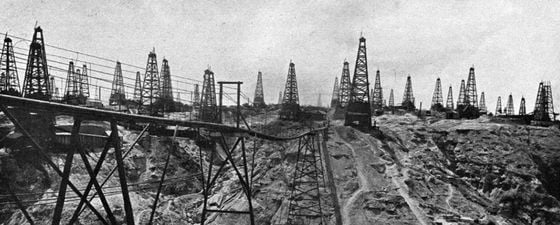With significant population and economic growth in the ASEAN countries, there is an urgent demand for new resources to feed this and future development and reduce dependence on coal and imported oil.
Producing oil with hand-dug wells in Myanmar. Photo Credit: Amy Gough.
South East Asia holds only a relatively small percentage of the world’s oil and gas (about 2% of total proved oil reserves and 5% of total gas), but has nonetheless played an important role in the development of the industry. Oil produced using hand-dug wells in Sarawak was mentioned in official Chinese documents in the 11th century and the process is thought to have been used in Myanmar as long ago as 900 BC. The first commercial well in South East Asia was drilled in 1885 in East Sumatra by Aeilko Jans Zijklert, a 25-year-old Dutch tobacco planter-turned-oil-explorer who, five years later, founded the Royal Dutch Company. Sadly, he died shortly afterwards, and was not able to see either the success of his discoveries or how his fledgling company eventually morphed into the supermajor we know as Shell.
As elsewhere, investment in exploration in the region reduced dramatically after the oil price collapse in 2014. Demand, however, has not – in fact, in the ten countries which make up the Association of South East Asian Nations (ASEAN), energy demand grew by 60% in the years between 2000 and 2017. Many of these countries have experienced significant economic growth, and the population of the ASEAN countries increased by an average of 23% during this time, so there is an urgent need for new resources to feed this economic development and reduce the strong dependence on coal and imported oil.
The Yenangyaung Oil Wells.
There have been signs of a rally in the market since the middle of 2018, albeit at a lower rate than in other parts of the world. In Vietnam, for example, PetroVietnam is developing a large gas field known as Block B, while in Indonesia significant investment is planned for the second phase of the giant Senoro gas field. In fact, it has been reported that as many as 50 oil and gas fields, with a collective resource of 4 Bboe, will be approved for development between 2018 and 2020. While some of this investment will focus on developing existing fields, a number of large new fields, such as the Pegara discovery offshore Sarawak, are in development, hoping to start production within the next couple of years.
Over three-quarters of the planned development is for gas fields. For many years, South East Asia had limited attraction to explorers as it was viewed as too gas-prone, but with economic development has come an increased demand for gas for both domestic and industrial uses throughout the region. The appetite for exploration in South East Asia should continue to grow.
About the Author
Jane Whaley
Editor in Chief | GEO ExPro Magazine
A geologist with 30 years experience in the oil industry, ranging from high resolution seismic surveys to technical studies with IHS, Jane has been involved with GEO ExPro Magazine since 2005. Previously Associate Editor, Europe and Africa, she has been Editor in Chief since 2010.




